For more information or to purchase any of the books in this series, please visit the University of Nebraska Press
Archaeology and Ethnohistory of the Omaha Indians: The Big Village Site
John Ludwickson, John M. O'SheaCloth: 1992, xviii, 374
CIP.LC 89-35986,0-8032-3556-9
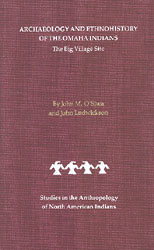 For seventy years, from about 1775 until 1845, Big Village was the principal settlement of the Omaha Indians. Situated on the Missouri River seventy-five miles above the present city of Omaha, it commanded a strategic location astride this major trade route to the northern plains. A host of traders and travelers, from Jean-Baptiste Truteau and James Mackay to Lewis and Clark and Father De Smet, left descriptions of the village. Although John Champe of the University of Nebraska carried out a comprehensive archaeological investigation of the site from 1939 to 1942 (the only intensive, systematic archaeological study of any Omaha site), the results of his work have heretofore remained unpublished. Now John M. O'Shea and John Ludwickson have combined Champe's findings with major historical accounts of the Omahas, providing significant new insights into the course of Omaha history in the preservation period.
For seventy years, from about 1775 until 1845, Big Village was the principal settlement of the Omaha Indians. Situated on the Missouri River seventy-five miles above the present city of Omaha, it commanded a strategic location astride this major trade route to the northern plains. A host of traders and travelers, from Jean-Baptiste Truteau and James Mackay to Lewis and Clark and Father De Smet, left descriptions of the village. Although John Champe of the University of Nebraska carried out a comprehensive archaeological investigation of the site from 1939 to 1942 (the only intensive, systematic archaeological study of any Omaha site), the results of his work have heretofore remained unpublished. Now John M. O'Shea and John Ludwickson have combined Champe's findings with major historical accounts of the Omahas, providing significant new insights into the course of Omaha history in the preservation period.
The emphasis on material culture gives a unique view of the daily life of these people and illustrates clearly the integration of European trade items with traditional technologies. Here the fur trade is seen in a fresh perspective, that of the suppliers of furs and recipients of trade goods. An examination of Omaha demography rounds out this important new ethnohistorical sketch of the Omaha Indians.
John M. O'Shea is an associate professor of anthropology and associate curator of the Museum of Anthropology at the University of Michigan and John Ludwickson in an archaeologist with the Nebraska State Historical Society. They have both published widely in professional journals and books.
The Canadian Sioux
James H. HowardCloth: 1984, xvi, 207
CIP.LC 83-23506,0-8032-2327-7
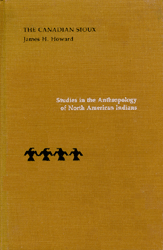 The Canadian Sioux are descendants of Santees, Yanktonais, and Tetons from the United States who sought refuge in Canada during the 1860s and 1870s. Living today on eight reserves in Manitoba and Saskatchewan, they have been largely neglected by anthropologists and historians and are the least well known of all the Sioux groups. This study by a long-time student of Sioux and other Indian cultures fills that gap in the literature.
The Canadian Sioux are descendants of Santees, Yanktonais, and Tetons from the United States who sought refuge in Canada during the 1860s and 1870s. Living today on eight reserves in Manitoba and Saskatchewan, they have been largely neglected by anthropologists and historians and are the least well known of all the Sioux groups. This study by a long-time student of Sioux and other Indian cultures fills that gap in the literature.
Based on fieldwork done in the 1970s supplemented by written sources, The Canadian Sioux presents a descriptive reconstruction of their traditional culture, many aspects of which are still practiced or remembered by Canadian Sioux today although long forgotten by their relatives in the United States. It is rich in detail and presents an abundance of new information on topics such as tribal divisions, documented history and traditional history, warfare, their economy, social life, philosophy and religion, and ceremonialism. Nearly half the book is devoted to Canadian Sioux religion and describes such ceremonies as the vision quest, medicine feast, medicine dance, sun dance, warrior society dances, and the Ghost Dance.
A welcome addition to American Indian ethnography, James H. Howard's study provides a valuable overview of Canadian Sioux culture and a fine introduction to these little-known groups.
The late James H. Howard was a professor of anthropology at Oklahoma State University at the time of his death in 1982. His many publications include The Warrior Who Killed Custer: The Personal Narrative of Chief Joseph White Bull (1968, also published by the University of Nebraska Press) and Shawnee: The Ceremonialism of a Native American Tribe and Its Cultural Background (1981).
Ceremonies of the Pawnee
Douglas R. Parks, James R. MurieCloth: 1989, xiv, 497
CIP.LC 88-28290,0-8032-3138-5 Paper: 1989,,,CIP.LC ,0-8032-8162-5
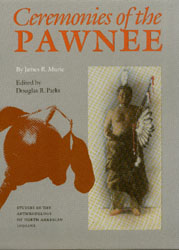 "Here it is -Murie as it should have been, beautifully and expertly edited, embellished with forgotten pictures, and ready for use and study- a permanent gift to the world of anthropology, the Caddoans, and the Plains." -Alexander Lesser. "These detailed descriptions of the major Pawnee Indian ceremonies are unique in Plains Indian literature." -John C. Ewers. Of all the American Indian tribes of the Plains, the Pawnee and the closely related Arikara developed their religious philosophy and ceremonialism to its fullest; in fact, they may have developed it more highly than any other group north of Mexico. Ceremonies of the Pawnee is the first and only systematic, comprehensive description of that rich and complex religious life. Written under the direction of the anthropologist Clark Wissler between 1914 and 1920, it is the culmination of the ethnographic studies of James R. Murie, himself a Pawnee, who witnessed and participated in revivals of the ceremonialism just before it finally died out. Part I presents the annual ritualistic cycle of the Skiri band, giving detailed accounts of the major ceremonies and describing the role of priests, doctors, and bundles in Pawnee religion. Part II is devoted to three major doctors' ceremonies -the White Beaver Ceremony, the Bear Dance, and the Buffalo Dance- one of the three groups known collectively as the South Bands. The descriptions include, in both the original Pawnee and an English translation, several hundred songs as well as a number of ceremonial chants and speeches that are virtually unique in the literature on American Indian religion and provide invaluable material for linguistic study. Equally valuable is the collection of vision stories that underlie the songs. As a body they provide a new perspective on the vision and its cultural patterning, and allow for a deeper understanding of the cultural and psychological bases of Pawnee religion. Dr. Douglas R. Parks of the American Indian Studies Research Institute at Indiana University has provided an overview of Pawnee social organization and religion, along with explanatory notes and a biography of Murie.
"Here it is -Murie as it should have been, beautifully and expertly edited, embellished with forgotten pictures, and ready for use and study- a permanent gift to the world of anthropology, the Caddoans, and the Plains." -Alexander Lesser. "These detailed descriptions of the major Pawnee Indian ceremonies are unique in Plains Indian literature." -John C. Ewers. Of all the American Indian tribes of the Plains, the Pawnee and the closely related Arikara developed their religious philosophy and ceremonialism to its fullest; in fact, they may have developed it more highly than any other group north of Mexico. Ceremonies of the Pawnee is the first and only systematic, comprehensive description of that rich and complex religious life. Written under the direction of the anthropologist Clark Wissler between 1914 and 1920, it is the culmination of the ethnographic studies of James R. Murie, himself a Pawnee, who witnessed and participated in revivals of the ceremonialism just before it finally died out. Part I presents the annual ritualistic cycle of the Skiri band, giving detailed accounts of the major ceremonies and describing the role of priests, doctors, and bundles in Pawnee religion. Part II is devoted to three major doctors' ceremonies -the White Beaver Ceremony, the Bear Dance, and the Buffalo Dance- one of the three groups known collectively as the South Bands. The descriptions include, in both the original Pawnee and an English translation, several hundred songs as well as a number of ceremonial chants and speeches that are virtually unique in the literature on American Indian religion and provide invaluable material for linguistic study. Equally valuable is the collection of vision stories that underlie the songs. As a body they provide a new perspective on the vision and its cultural patterning, and allow for a deeper understanding of the cultural and psychological bases of Pawnee religion. Dr. Douglas R. Parks of the American Indian Studies Research Institute at Indiana University has provided an overview of Pawnee social organization and religion, along with explanatory notes and a biography of Murie.
Comanche Political History An Ethnohistorical Perspective
Thomas W. KavanaghCloth: 1996, xvi, 586
CIP.LC 96-391,0-8032-2730-2
 The Comanche Indians are one of the most widely known yet least understood groups on the Plains. Although much has been published on Comanche history and culture, this is the first in-depth historical study of Comanche social and political groups. Using the ethnohistorical method, Thomas W. Kavanagh traces the changes and continuities in Comanche politics from their earliest interactions with Europeans to their settlement on a reservation in present-day Oklahoma. Based on documentary material from historical and anthropological archives in Spain, Mexico, and the United States, the book examines the different ways the Comanche tribes -the Yamparikas, Jupes, Kotsotekas, Quahadas, Penatekas, Tenewas, and Nokonis organized and reorganized themselves around the changing resource domains of hunting, warfare, trade, and diplomacy. The book presents detailed histories of each of the Comanche tribes and raises larger questions about political processes. What are the origins and fates of political organizations? Why do peoples come together? Why do they disperse? In classical political philosophy, tribes, nations, and ethnic groups have clear, unchanging boundaries; their origins are mythical and unknowable, and their collapse is pathological. In contrast, using the record of the Comanches, Kavanagh argues that political formation and re-formation is not only normal but frequently ignores existing political and ethnic boundaries. Thomas W. Kavanagh is curator of the William Hammond Mathers Museum, Indiana University. He has published articles in such journals as Visual Anthropology and Plains Anthropologist.
The Comanche Indians are one of the most widely known yet least understood groups on the Plains. Although much has been published on Comanche history and culture, this is the first in-depth historical study of Comanche social and political groups. Using the ethnohistorical method, Thomas W. Kavanagh traces the changes and continuities in Comanche politics from their earliest interactions with Europeans to their settlement on a reservation in present-day Oklahoma. Based on documentary material from historical and anthropological archives in Spain, Mexico, and the United States, the book examines the different ways the Comanche tribes -the Yamparikas, Jupes, Kotsotekas, Quahadas, Penatekas, Tenewas, and Nokonis organized and reorganized themselves around the changing resource domains of hunting, warfare, trade, and diplomacy. The book presents detailed histories of each of the Comanche tribes and raises larger questions about political processes. What are the origins and fates of political organizations? Why do peoples come together? Why do they disperse? In classical political philosophy, tribes, nations, and ethnic groups have clear, unchanging boundaries; their origins are mythical and unknowable, and their collapse is pathological. In contrast, using the record of the Comanches, Kavanagh argues that political formation and re-formation is not only normal but frequently ignores existing political and ethnic boundaries. Thomas W. Kavanagh is curator of the William Hammond Mathers Museum, Indiana University. He has published articles in such journals as Visual Anthropology and Plains Anthropologist.
Corbett Mack The Life of a Northern Paiute
Michael HittmanCloth: 1996,xvi,396
CIP.LC 96-28492,0-8032-2376-5 Paper: 1996,xvi,396,CIP.LC 96-28492,0-8032-7290-1
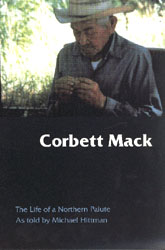 This is the compelling yet disturbing story of Corbett Mack (1892-1974), an opiate addict who was a member of the Nuumuu (Numa), or Northern Paiute. The Northern Paiute are best known as the people who produced Wovoka, the Ghost Dance prophet whose revitalistic teachings swept the Indian world in the 1890s. Mack is from the generation following the collapse of the Ghost Dance religion, a generation of Nomogweta or "half-breeds" (also called "stolen children"). Paiute of mixed ancestry who were raised in an increasingly bicultural world and who fell into virtual peonage to white (often Italian) potato farmers. Around the turn of the century, the use of opium became widespread among the Paiute, adopted from equally victimized Chinese laborers with whom they worked closely in the fields. The story of Corbett Mack is an uncompromising account of a harsh and sometimes traumatic life that was typical of an entire generation of Paiute. It was a life born out of the turmoil and humiliation of an Indian boarding school, troubled by opiate addiction, bound to constant labor in the fields, yet nonetheless made meaningful through the perseverance of Paiute cultural traditions. Michael Hittman is chairman of the Anthropology and Sociology Department and a professor at Long Island University, Brooklyn. He is the author of Wovoka and the Ghost Dance: A Sourcebook and A Numa History: The Yerington Paiute Tribe.
This is the compelling yet disturbing story of Corbett Mack (1892-1974), an opiate addict who was a member of the Nuumuu (Numa), or Northern Paiute. The Northern Paiute are best known as the people who produced Wovoka, the Ghost Dance prophet whose revitalistic teachings swept the Indian world in the 1890s. Mack is from the generation following the collapse of the Ghost Dance religion, a generation of Nomogweta or "half-breeds" (also called "stolen children"). Paiute of mixed ancestry who were raised in an increasingly bicultural world and who fell into virtual peonage to white (often Italian) potato farmers. Around the turn of the century, the use of opium became widespread among the Paiute, adopted from equally victimized Chinese laborers with whom they worked closely in the fields. The story of Corbett Mack is an uncompromising account of a harsh and sometimes traumatic life that was typical of an entire generation of Paiute. It was a life born out of the turmoil and humiliation of an Indian boarding school, troubled by opiate addiction, bound to constant labor in the fields, yet nonetheless made meaningful through the perseverance of Paiute cultural traditions. Michael Hittman is chairman of the Anthropology and Sociology Department and a professor at Long Island University, Brooklyn. He is the author of Wovoka and the Ghost Dance: A Sourcebook and A Numa History: The Yerington Paiute Tribe.
The Dakota Way of Life
Ella Cara Deloria, Raymond J. DeMallie, Thierry Veyrié
Cloth: 2022, 440
ISBN: 9781496233592
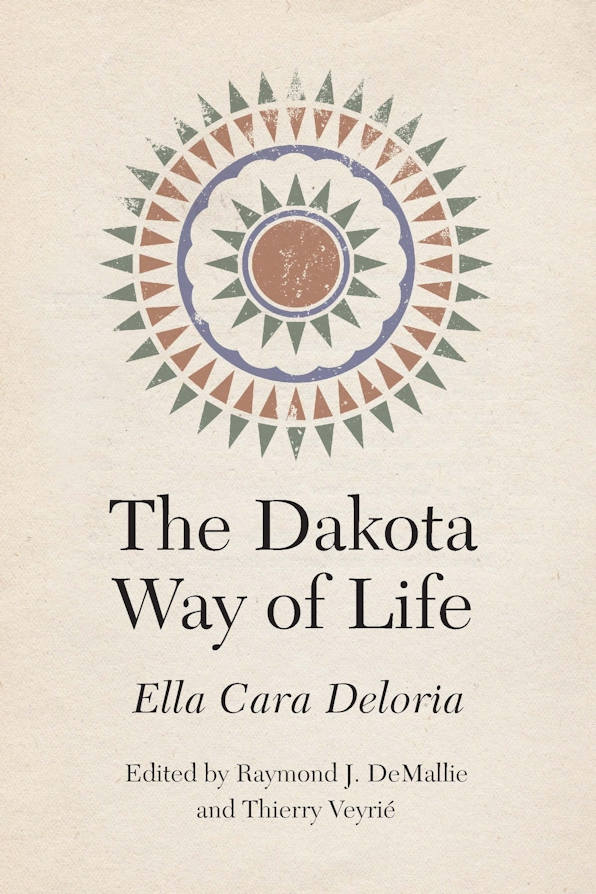 Ella Cara Deloria devoted much of her life to the study of the language and culture of the Sioux (Dakota and Lakota). The Dakota Way of Life is the result of the long history of her ethnographic descriptions of traditional Dakota culture and social life. Deloria was the most prolific Native scholar of the greater Sioux Nation, and the results of her work comprise an essential source for the study of the greater Sioux Nation culture and language. For years she collected material for a study that would document the variations from group to group. Tragically, her manuscript was not published during her lifetime, and at the end of her life all of her major works remained unpublished.
Ella Cara Deloria devoted much of her life to the study of the language and culture of the Sioux (Dakota and Lakota). The Dakota Way of Life is the result of the long history of her ethnographic descriptions of traditional Dakota culture and social life. Deloria was the most prolific Native scholar of the greater Sioux Nation, and the results of her work comprise an essential source for the study of the greater Sioux Nation culture and language. For years she collected material for a study that would document the variations from group to group. Tragically, her manuscript was not published during her lifetime, and at the end of her life all of her major works remained unpublished.
Deloria was a perfectionist who worked slowly and cautiously, attempting to be as objective as possible and revising multiple times. As a result, her work is invaluable. Her detailed cultural descriptions were intended less for purposes of cultural preservation than for practical application. Deloria was a scholar through and through, and yet she never let her dedication to scholarship overwhelm her sense of responsibility as a Dakota woman, with family concerns taking precedence over work. Her constant goal was to be an interpreter of an American Indian reality to others. Her studies of the Sioux are a monument to her talent and industry.
A Dictionary of Creek/Muskogee
Jack B. Martin and Margaret McKane MauldinCloth: 2000, xxxviii, 359
CIP.LC 00-027202 ISBN : 0-8032-3207-1
”Any tribe that is considering publishing a language dictionary would do well to browse this book as a possible model for the format….It would be an asset to all tribal collections.”—American Indian Libraries
The result of over ten years of research, A Dictionary of Creek/Muskogee draws on the expertise of a linguist and a native Creek speaker to yield the first modern dictionary of the Creek language of the southeastern United States. The dictionary contains over seven thousand Creek-English entries, over four thousand English-Creek entries, and over four hundred Creek place-names in Alabama, Georgia, Florida, and Oklahoma. The volume also includes illustrations, a map, antonyms, dialects, stylistic information, word histories, and other useful reference material. Entries are given in both the traditional Creek spelling and a modern phonemic transcription. A Dictionary of Creek/Muskogee is the standard reference work for the Creek language.
Jack B. Martin is an associate professor of English at the College of William and Mary and a specialist in southeastern Native languages. Margaret McKane Mauldin is an adjunct instructor of Creek at the University of Oklahoma.
The Four Hills of Life: Northern Arapaho Knowledge and Life Movement
Jeffrey D. AndersonCloth: 2003, xiv, 358
CIP.LC 2002071466 ISBN : 0-8032-1061-2
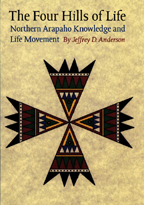 Sherman Sage (ca. 1844–1943) was an unforgettable Arapaho man who witnessed profound change in his community and was one of the last to see the Plains black with buffalo. As a young warrior, Sage defended his band many times, raided enemy camps, saw the first houses go up in Denver, was present at Fort Laramie for the signing of the 1868 treaty, and witnessed Crazy Horse’s surrender. Later, he visited the Ghost Dance prophet Wovoka and became a link in the spread of the Ghost Dance religion to other Plains Indian tribes. As an elder, Old Man Sage was a respected, vigorous leader, walking miles to visit friends and family even in his nineties. One of the most interviewed Native Americans in the Old West, Sage was a wellspring of information for both Arapahos and outsiders about older tribal customs.
Sherman Sage (ca. 1844–1943) was an unforgettable Arapaho man who witnessed profound change in his community and was one of the last to see the Plains black with buffalo. As a young warrior, Sage defended his band many times, raided enemy camps, saw the first houses go up in Denver, was present at Fort Laramie for the signing of the 1868 treaty, and witnessed Crazy Horse’s surrender. Later, he visited the Ghost Dance prophet Wovoka and became a link in the spread of the Ghost Dance religion to other Plains Indian tribes. As an elder, Old Man Sage was a respected, vigorous leader, walking miles to visit friends and family even in his nineties. One of the most interviewed Native Americans in the Old West, Sage was a wellspring of information for both Arapahos and outsiders about older tribal customs.
Anthropologist Jeffrey D. Anderson gathered information about Sage’s long life from archives, interviews, recollections, and published sources and has here woven it into a compelling biography. We see different sides of Sage—how he followed a traditional Arapaho life path; what he learned about the Rocky Mountains and Plains; what he saw and did as outsiders invaded the Arapahos’ homeland in the nineteenth century; how he adjusted, survived, and guided other Arapahos during the early reservation years; and how his legacy lives on today. The remembrances of Old Man Sage’s relatives and descendants of friends make apparent that his vision and guidance were not limited to his lifetime but remain vital today in the Northern Arapaho tribe.
Jeffrey D. Anderson is an associate professor of anthropology at Colby College. He is the author of The Four Hills of Life: Northern Arapaho Knowledge and Life Movement (Nebraska 2001).
A Grammar of Comanche
Jean Ormsbee CharneyCloth: 1994,x,273
CIP.LC 93-30300,0-8032-1461-8
 Comanche belongs to the Numic branch of the Uto-Aztecan language family. It is spoken by a handful of people (generally aged 70 and older), most of whom live in the vicinity of Lawton, Oklahoma. This study is based on the model of descriptive grammar developed by Mary Haas and her students at the University of California at Berkeley in the 1950's and 1960's. The phonology, morphology, and syntax of the language are described and exemplified in some detail. Comanche manifests the phonological final features of most Numic languages. Its morphology is fairly easy to identify, with little in the way of complex morphophonemics beyond the final feature system. There is a wealth of affixation in many areas of the language-for instance, the instrumental prefixes, the postpositions, and the verbal suffixes. The pronominal systems contain many different forms, and nominals and pronominals are inflected for subjective, objective, and possessive case. The most important element of the sentence is usually marked with one of two topic markers, and demonstratives are marked for the speaker's presumption of the hearer's knowledge of their referents. Sentences with subordinate clauses manifest the switch reference system that is characteristic of Numic languages.
Comanche belongs to the Numic branch of the Uto-Aztecan language family. It is spoken by a handful of people (generally aged 70 and older), most of whom live in the vicinity of Lawton, Oklahoma. This study is based on the model of descriptive grammar developed by Mary Haas and her students at the University of California at Berkeley in the 1950's and 1960's. The phonology, morphology, and syntax of the language are described and exemplified in some detail. Comanche manifests the phonological final features of most Numic languages. Its morphology is fairly easy to identify, with little in the way of complex morphophonemics beyond the final feature system. There is a wealth of affixation in many areas of the language-for instance, the instrumental prefixes, the postpositions, and the verbal suffixes. The pronominal systems contain many different forms, and nominals and pronominals are inflected for subjective, objective, and possessive case. The most important element of the sentence is usually marked with one of two topic markers, and demonstratives are marked for the speaker's presumption of the hearer's knowledge of their referents. Sentences with subordinate clauses manifest the switch reference system that is characteristic of Numic languages.
JEAN ORMSBEE CHARNEY is a member of the Center for the Study of the Native Languages of the Plains and the Southwest at the University of Colorado, Boulder, Colorado. She received a Ph.D. in linguistics from that university. She is presently pursuing studies of Comanche and is also working as an editor and production manager for the oral history phases of the Nye County, Nevada, and Lincoln County, Nevada, town history projects. .
Great Plains Ethnohistory: New Interdisciplinary Approaches
Rani-Henrik Andersson,Thierry Veyrié, Logan Sutton
Cloth: 2024, 408
ISBN: 9781496242099
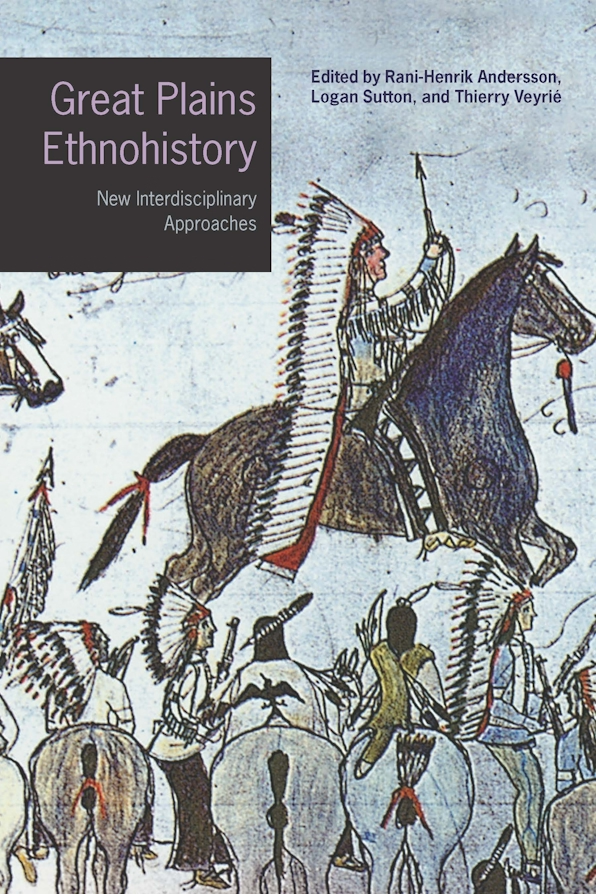 Great Plains Ethnohistory offers a collection of state-of-the-field work in Great Plains ethnohistory, both contemporary and historical, covering the traditional anthropological subfields of ethnography, cultural history, archaeology, and linguistics. As ethnohistory matured into an interdisciplinary endeavor in the 1950s with the formation of the American Society for Ethnohistory, historians and anthropologists developed scholarly methodology for the study of Native American societies from their own points of view. Within this developing framework, Native cultures of the Great Plains represented a foundational research area.
Great Plains Ethnohistory offers a collection of state-of-the-field work in Great Plains ethnohistory, both contemporary and historical, covering the traditional anthropological subfields of ethnography, cultural history, archaeology, and linguistics. As ethnohistory matured into an interdisciplinary endeavor in the 1950s with the formation of the American Society for Ethnohistory, historians and anthropologists developed scholarly methodology for the study of Native American societies from their own points of view. Within this developing framework, Native cultures of the Great Plains represented a foundational research area.
Great Plains Ethnohistory pays intellectual debts to Raymond J. DeMallie and Douglas R. Parks, whose research from the 1970s onward brought ethnohistorical approaches to the study of Native cultures, histories, and languages into the international community of the humanities and social sciences, sciences, and arts. The work of the scholars assembled in this volume advocates for an ethnohistory that continues to decompartmentalize Indigenous knowledge and scholarly methodologies, including some of the constructs, biases, and prejudices perpetuated within traditional scholarly disciplines.
Including essays by Gilles Havard, Joanna Scherer, Sebastian Braun, Brad KuuNUx TeeRIt Kroupa, and DeMallie and Parks themselves, among others, plus an afterword by Philip J. Deloria, this is an essential contribution to the scholarly field and a volume for undergraduate and graduate students and scholars who study Native American and Indigenous cultures.
Haida Syntax, 2-Volume Set
John EnricoCloth: 2003, xiii, 1387
CIP.LC 2002075095 ISBN : 0-8032-1822-2
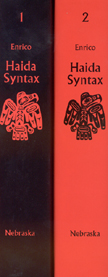 "Haida Syntax makes an enormous contribution to our understanding of the syntax and semantics of Haida. There is very little published material available on this language, and in this book John Enrico brings together a rich range of syntactic and semantic material on the language. . . . A book of this magnitude will make Haida one of the syntactically best described languages." - Keren Rice, author of Morpheme Order and Semantic Scope: Word Formation in the Athapaskan Verb.
"Haida Syntax makes an enormous contribution to our understanding of the syntax and semantics of Haida. There is very little published material available on this language, and in this book John Enrico brings together a rich range of syntactic and semantic material on the language. . . . A book of this magnitude will make Haida one of the syntactically best described languages." - Keren Rice, author of Morpheme Order and Semantic Scope: Word Formation in the Athapaskan Verb.
"One of the most valuable features of Haida Syntax is the semantic detail that is given regarding verbs, constructions, etc. This will be immensely useful to linguists of all theoretical persuasions, as they try their hand at analyzing this fascinating language within their own theoretical framework. Also, the extensive discussion of focus and its role within the grammar is very valuable."-Robert D. Van Valin, author of An Introduction to Syntax. The Haida people make their home on the Queen Charlotte Islands in British Columbia and on Prince of Wales Island off the coast of southern Alaska. Their language, distinct from their Northwest Coast neighbors, is spoken today by a few elders and is in danger of becoming extinct, despite efforts by the community to save it. Intimately familiar with the Haida language, John Enrico bases this comprehensive description of the syntax of two Haida dialects on his twenty-five years of fieldwork in the Haida community and on the materials collected by the anthropologist John Swanton in the early twentieth century. This synthesis of the syntax of the Haida language provides an exemplary reference work of the language for the Haida community and for scholars.
John Enrico, an independent scholar, is the author of The Lexical Phonology of Masset Haida, editor and translator of Skidegate Haida Myths and Histories, and coauthor (with Wendy Bross Stuart) of Northern Haida Songs (Nebraska 1996). He is currently working on a dictionary of the three extant Haida dialects..
The Heiltsuks Dialogues of Culture and History on the Northwest Coast
Michael E. HarkinCloth: 1997, xiv, 195
CIP.LC 95-46842,0-8032-2379-X
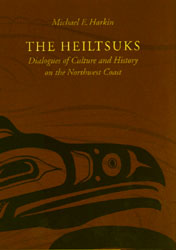 "Outstanding . . . What Marshall Sahlins has done for the Hawaiians, Michael Harkin has done for the Heiltsuks." -Sergei Kan, Dartmouth College. In an incisive and wide-ranging critique of ethnohistory and historical anthropology, Michael Harkin develops an innovative approach to understanding the profound cultural changes experienced during the past century by the Heiltsuks (Bella Bella), a Northwest Coast Indian group. Between 1880 and 1920, the Heiltsuks changed from one of the most traditional and aggressive groups on the Northwest Coast to paragons of Victorian virtues. Why and how did this dramatic transformation occur? These questions, Harkin contends, can best be answered by tracing the changing views the Heiltsuks had of themselves and of their past as they encountered colonial powers. Rejecting many of the common methods and assumptions of ethnohistorians as unwittingly Eurocentric or simplistic, Harkin argues that the multiple perspectives, motives, and events constituting the Heiltsuks' world and history can be productively conceived of as dialogues, ongoing series of culturally embedded communicative acts that presuppose previous acts and constrain future ones. Historical transformations in three of these dialogues, centering on the body, material goods, and concepts of the soul, are examined in detail. A valuable history of a little-known Indian group and a highly original investigation into the dynamics of colonial encounters, the nature of cultural memory, and the processes of cultural stability and change, this provocative study sets the agenda for a new type of ethnohistory. Michael E. Harkin is an assistant professor of anthropology at the University of Wyoming. This is his first book.
"Outstanding . . . What Marshall Sahlins has done for the Hawaiians, Michael Harkin has done for the Heiltsuks." -Sergei Kan, Dartmouth College. In an incisive and wide-ranging critique of ethnohistory and historical anthropology, Michael Harkin develops an innovative approach to understanding the profound cultural changes experienced during the past century by the Heiltsuks (Bella Bella), a Northwest Coast Indian group. Between 1880 and 1920, the Heiltsuks changed from one of the most traditional and aggressive groups on the Northwest Coast to paragons of Victorian virtues. Why and how did this dramatic transformation occur? These questions, Harkin contends, can best be answered by tracing the changing views the Heiltsuks had of themselves and of their past as they encountered colonial powers. Rejecting many of the common methods and assumptions of ethnohistorians as unwittingly Eurocentric or simplistic, Harkin argues that the multiple perspectives, motives, and events constituting the Heiltsuks' world and history can be productively conceived of as dialogues, ongoing series of culturally embedded communicative acts that presuppose previous acts and constrain future ones. Historical transformations in three of these dialogues, centering on the body, material goods, and concepts of the soul, are examined in detail. A valuable history of a little-known Indian group and a highly original investigation into the dynamics of colonial encounters, the nature of cultural memory, and the processes of cultural stability and change, this provocative study sets the agenda for a new type of ethnohistory. Michael E. Harkin is an assistant professor of anthropology at the University of Wyoming. This is his first book.
Koasati Dictionary
Geoffrey D. KimballCloth: 1994, xxxv, 407
CIP.LC 94-16427,0-8032-2726-4
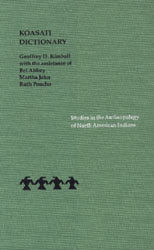 Koasati Dictionary is one of the first modern dictionaries ever published of a language of the Muskogean language family, whose speakers formerly occupied most of the southeastern United States. When first met by Europeans in the sixteenth century, the Koasati people were living in eastern Tennessee. Early in the eighteenth century they moved to south central Alabama and eventually migrated to present-day Louisiana, Texas, and Oklahoma. Today their language survives in southwestern Louisiana, where it is still spoken by the majority of tribal members living there.
Koasati Dictionary is one of the first modern dictionaries ever published of a language of the Muskogean language family, whose speakers formerly occupied most of the southeastern United States. When first met by Europeans in the sixteenth century, the Koasati people were living in eastern Tennessee. Early in the eighteenth century they moved to south central Alabama and eventually migrated to present-day Louisiana, Texas, and Oklahoma. Today their language survives in southwestern Louisiana, where it is still spoken by the majority of tribal members living there.
Published three years after Kimball's richly detailed Koasati Grammar, this dictionary is the second of three monographs to result from his fifteen-year study of the language. In this work, Kimball provides the user with a substantial introduction outlining Koasati grammar and then organizes dictionary entries into two parts, the first arranged from Koasati to English and the second from English to Koasati. In addition to English translations, entries in the Koasati-English section include sample sentences that illustrate word usage as well as illuminate traditional Koasati culture. Most of these sentences are taken from narrative texts.
The dictionary, like Kimball's grammar of Koasati, is an indispensable reference work for linguists, anthropologists, and historians—indeed, for anyone interested in the native culture history of the southeastern United States.
Geoffrey D. Kimball is a post-doctoral fellow in the Department of Anthropology, Tulane University.
Koasati Grammar
Geoffrey D. Kimball
Cloth: 1991, xxx, 640
CCIP.LC 90-12277,0-8032-2725-6
 An American Indian language belonging to the Muskogean linguistic family, Koasati is spoken today by fewer than five hundred people living in southwestern Louisiana and on the Alabama-Coushatta Indian Reservation in Texas. Geoffrey D. Kimball has collected material from the speakers of the larger Louisiana community to produce the first comprehensive description of Koasati.
An American Indian language belonging to the Muskogean linguistic family, Koasati is spoken today by fewer than five hundred people living in southwestern Louisiana and on the Alabama-Coushatta Indian Reservation in Texas. Geoffrey D. Kimball has collected material from the speakers of the larger Louisiana community to produce the first comprehensive description of Koasati.
The book opens with a brief history of the Koasati. The chapters that follow describe Koasati phonology, verb conjugation classes and inflectional morphology, verb derivation, noun inflectional and derivational morphology, grammatical particles, and syntax and semantics. A discussion of Koasati speech styles illustrated with texts concludes the book. Because examples of grammatical construction are drawn from native speakers in naturally occurring discourse, they authoritatively document aspects of a language that is little known.
Geoffrey D. Kimball is a post-doctoral fellow in the Department of Anthropology at Tulane University.
The Lakota Ritual of the Sweat Lodge History and Contemporary Practice
Raymond A. Bucko
Cloth: 1998,vii,340
CIP.LC 97-47504,0-8032-1272-0
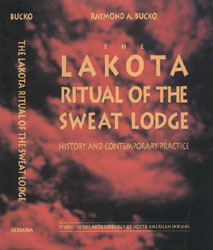 For centuries, a persistent and important component of Lakota religious life has been the Inipi, the ritual of the sweat lodge. The sweat lodge has changed little in appearance since its first recorded description in the late seventeenth century. The ritual held within, the "sweat" consists of songs, prayers, and other actions conducted in a tightly enclosed, extremely hot and stifling environment. Participants who "sweat" together experience moral purification and even physical healing. Today, the sweat lodge ritual continues to be a vital part of Lakota religion. It has recently become popular among Lakotas recovering from alcohol and drug addiction and among those afflicted with AIDS. This impressive study is the first in-depth look at the history and significance of the Lakota sweat lodge. Bringing together data culled from historical sources and recent fieldwork at Pine Ridge Reservation, Raymond A. Bucko provides a detailed discussion of changes that have occurred in the structure and function of the "sweat" ritual over time. He offers convincing explanations for the longevity of the sweat lodge and its continuing popularity. The ritual survives because it is inherently malleable, girded by fixed physical and symbolic forms but continually subject to reinterpretation and creative modification. Consequently, the Lakotas are able to adapt this important healing ritual to meet their changing collective and individual needs. Raymond A. Bucko is an assistant professor of anthropology at Le Moyne College. His articles have appeared in European Review of Native American Studies and Mission. This is his first book.
For centuries, a persistent and important component of Lakota religious life has been the Inipi, the ritual of the sweat lodge. The sweat lodge has changed little in appearance since its first recorded description in the late seventeenth century. The ritual held within, the "sweat" consists of songs, prayers, and other actions conducted in a tightly enclosed, extremely hot and stifling environment. Participants who "sweat" together experience moral purification and even physical healing. Today, the sweat lodge ritual continues to be a vital part of Lakota religion. It has recently become popular among Lakotas recovering from alcohol and drug addiction and among those afflicted with AIDS. This impressive study is the first in-depth look at the history and significance of the Lakota sweat lodge. Bringing together data culled from historical sources and recent fieldwork at Pine Ridge Reservation, Raymond A. Bucko provides a detailed discussion of changes that have occurred in the structure and function of the "sweat" ritual over time. He offers convincing explanations for the longevity of the sweat lodge and its continuing popularity. The ritual survives because it is inherently malleable, girded by fixed physical and symbolic forms but continually subject to reinterpretation and creative modification. Consequently, the Lakotas are able to adapt this important healing ritual to meet their changing collective and individual needs. Raymond A. Bucko is an assistant professor of anthropology at Le Moyne College. His articles have appeared in European Review of Native American Studies and Mission. This is his first book.
Lushootseed Texts An Introduction to Puget Salish Narrative Aesthetics
T. C. S. Langen, Edward (Hagen) Sam, Martha Lamont, Emma Conrad, Thomas Hess, Vi Hilbert, Crisca Bierwert, Crisca Bierwert
Cloth: 1989, xiv, 497
CIP.LC 88-28290,0-8032-3138-5, Paper: 1989 CIP.LC ,0-8032-8162-5
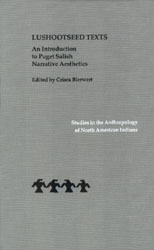 This volume introduces the oral literature of Native American peoples in Puget Salish-speaking areas of western Washington. Seven stories told by Lushootseed elders are transcribed and translated into English, accompanied by information on narrative design and cultural background. Upper Skagit elder and co-translator Vi Hilbert, a 1994 recipient of the NEH National Heritage Fellowship in Folk Arts, includes a cultural welcome and offers childhood reminiscences of the storytellers. Co-translator Thomas M. Hess, associate professor of linguistics at the University of Victoria, parses the beginning lines of a text to show the grammatical structures; he also includes his recollections of working with the storytellers in the 1960s as a graduate student. Editor and co-translator Crisca Bierwert, assistant professor of anthropology at the University of Michigan, provides information on the processes of language translation and of rendering oral traditions into written form. Annotator T. C. S. Langen, who holds a Ph.D. in English literature and is a curriculum developer for the Tulalip tribe, provides analyses of Lushootseed poetics. The book includes information about purchasing audiotapes of the stories.
This volume introduces the oral literature of Native American peoples in Puget Salish-speaking areas of western Washington. Seven stories told by Lushootseed elders are transcribed and translated into English, accompanied by information on narrative design and cultural background. Upper Skagit elder and co-translator Vi Hilbert, a 1994 recipient of the NEH National Heritage Fellowship in Folk Arts, includes a cultural welcome and offers childhood reminiscences of the storytellers. Co-translator Thomas M. Hess, associate professor of linguistics at the University of Victoria, parses the beginning lines of a text to show the grammatical structures; he also includes his recollections of working with the storytellers in the 1960s as a graduate student. Editor and co-translator Crisca Bierwert, assistant professor of anthropology at the University of Michigan, provides information on the processes of language translation and of rendering oral traditions into written form. Annotator T. C. S. Langen, who holds a Ph.D. in English literature and is a curriculum developer for the Tulalip tribe, provides analyses of Lushootseed poetics. The book includes information about purchasing audiotapes of the stories.
The Medicine Men Oglala Sioux Ceremony and Healing
Thomas H. Lewis
Cloth: 1990
CIP.LC ,0-8032-2890-2 Paper: 1990,viii,219,CIP.LC 89-22508,0-8032-7939-6
 For the residents of the Pine Ridge reservation in South Dakota, mainstream medical care is often supplemented or replaced by a host of traditional practices: the Sun Dance, the yuwipi sing, the heyok'a ceremony, herbalism, the Sioux Religion, the peyotism of the Native American Church, and other medicines, or sources of healing. Thomas H. Lewis, a psychiatrist and medical anthropologist, describes those practices as he encountered them in the late 1960s and early 1970s. During many months he studied with leading practitioners. He describes the healers, their techniques, personal histories and qualities, the problems addressed and results obtained and examines past as well as present practices. The result is an engrossing account that may profoundly affect the way readers view the dynamics of therapy for mind and body. Retired from the National Naval Medical Center, where he served as chief of psychiatry, and from Georgetown University School of Medicine, Thomas H. Lewis now lives in Montana.
For the residents of the Pine Ridge reservation in South Dakota, mainstream medical care is often supplemented or replaced by a host of traditional practices: the Sun Dance, the yuwipi sing, the heyok'a ceremony, herbalism, the Sioux Religion, the peyotism of the Native American Church, and other medicines, or sources of healing. Thomas H. Lewis, a psychiatrist and medical anthropologist, describes those practices as he encountered them in the late 1960s and early 1970s. During many months he studied with leading practitioners. He describes the healers, their techniques, personal histories and qualities, the problems addressed and results obtained and examines past as well as present practices. The result is an engrossing account that may profoundly affect the way readers view the dynamics of therapy for mind and body. Retired from the National Naval Medical Center, where he served as chief of psychiatry, and from Georgetown University School of Medicine, Thomas H. Lewis now lives in Montana.
Northern Haida Songs
Wendy Bross Stuart, John Enrico
Cloth: 1996, xiv, 519
CIP.LC 96-4211,0-8032-1816-8
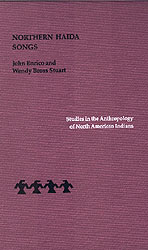 This book describes the musical culture of the Northern Haida Indians, who speak two closely related dialects. One dialect group lives on Graham Island, British Columbia, the other on Prince of Wales Island, Alaska. The recordings on which the book is based were compiled over a period of more than a decade from a wide variety of historical and contemporary sources. Representing the entire range of the Haida musical tradition -a tradition that nearly died out and is currently being revived- this volume documents its changes over more than a century. Part 1 is a lengthy ethnographic description of musical genres that situates Haida music in the context of the Northwest Coast. Part 2 presents 128 songs, fully transcribed and analyzed and representing some twenty types, ranging from traditional genres such as peace-making and mourning songs to songs of personal expression composed during the modern period. Part 3 is a detailed musical and linguistic analysis of the songs presented in the second part. The integration of descriptions of these two facets of song -music and language- is the particular goal of the book. The volume is a substantive contribution to the ethnomusicology of native North America and will be of special interest to scholars concerned with vocables in Native American music. John Enrico has been engaged in linguistic research on the Haida language since 1975. His publications include The Lexical Phonology of Masset Haida and articles on aspects of Haida grammar. Wendy Bross Stuart's first ethnomusicological publication was Gambling Music of the Coast Salish Indians. In 1980 she began collaborating with John Enrico in the transcription and analysis of Haida songs.
This book describes the musical culture of the Northern Haida Indians, who speak two closely related dialects. One dialect group lives on Graham Island, British Columbia, the other on Prince of Wales Island, Alaska. The recordings on which the book is based were compiled over a period of more than a decade from a wide variety of historical and contemporary sources. Representing the entire range of the Haida musical tradition -a tradition that nearly died out and is currently being revived- this volume documents its changes over more than a century. Part 1 is a lengthy ethnographic description of musical genres that situates Haida music in the context of the Northwest Coast. Part 2 presents 128 songs, fully transcribed and analyzed and representing some twenty types, ranging from traditional genres such as peace-making and mourning songs to songs of personal expression composed during the modern period. Part 3 is a detailed musical and linguistic analysis of the songs presented in the second part. The integration of descriptions of these two facets of song -music and language- is the particular goal of the book. The volume is a substantive contribution to the ethnomusicology of native North America and will be of special interest to scholars concerned with vocables in Native American music. John Enrico has been engaged in linguistic research on the Haida language since 1975. His publications include The Lexical Phonology of Masset Haida and articles on aspects of Haida grammar. Wendy Bross Stuart's first ethnomusicological publication was Gambling Music of the Coast Salish Indians. In 1980 she began collaborating with John Enrico in the transcription and analysis of Haida songs.
One Hundred Years of Old Man Sage: An Arapaho Life
Jeffrey D. Anderson
Cloth: 2003, x, 139
CIP.LC 2002071466 ISBN : 0-8032-1061-2
 Sherman Sage (ca. 1844–1943) was an unforgettable Arapaho man who witnessed profound change in his community and was one of the last to see the Plains black with buffalo. As a young warrior, Sage defended his band many times, raided enemy camps, saw the first houses go up in Denver, was present at Fort Laramie for the signing of the 1868 treaty, and witnessed Crazy Horse’s surrender. Later, he visited the Ghost Dance prophet Wovoka and became a link in the spread of the Ghost Dance religion to other Plains Indian tribes. As an elder, Old Man Sage was a respected, vigorous leader, walking miles to visit friends and family even in his nineties. One of the most interviewed Native Americans in the Old West, Sage was a wellspring of information for both Arapahos and outsiders about older tribal customs.
Sherman Sage (ca. 1844–1943) was an unforgettable Arapaho man who witnessed profound change in his community and was one of the last to see the Plains black with buffalo. As a young warrior, Sage defended his band many times, raided enemy camps, saw the first houses go up in Denver, was present at Fort Laramie for the signing of the 1868 treaty, and witnessed Crazy Horse’s surrender. Later, he visited the Ghost Dance prophet Wovoka and became a link in the spread of the Ghost Dance religion to other Plains Indian tribes. As an elder, Old Man Sage was a respected, vigorous leader, walking miles to visit friends and family even in his nineties. One of the most interviewed Native Americans in the Old West, Sage was a wellspring of information for both Arapahos and outsiders about older tribal customs.
Anthropologist Jeffrey D. Anderson gathered information about Sage’s long life from archives, interviews, recollections, and published sources and has here woven it into a compelling biography. We see different sides of Sage—how he followed a traditional Arapaho life path; what he learned about the Rocky Mountains and Plains; what he saw and did as outsiders invaded the Arapahos’ homeland in the nineteenth century; how he adjusted, survived, and guided other Arapahos during the early reservation years; and how his legacy lives on today. The remembrances of Old Man Sage’s relatives and descendants of friends make apparent that his vision and guidance were not limited to his lifetime but remain vital today in the Northern Arapaho tribe.
Jeffrey D. Anderson is an associate professor of anthropology at Colby College. He is the author of The Four Hills of Life: Northern Arapaho Knowledge and Life Movement (Nebraska 2001).
People of the Dalles The Indians of the Wascopam Mission
Robert Boyd
Cloth: 1996,xi,414
CIP.LC 95-38916,0-8032-1236-4
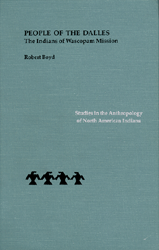 People of The Dalles is a historical ethnography of the Chinookan (Wasco-Wishram) and Sahaptin peoples of The Dalles area of the Columbia River (ancestors to peoples now located on the Warm Springs and Yakama reservations) between about 1805 and 1848. The book begins with early historical background reconstructed from the accounts of explorers and travelers, then presents the human geography, subsistence and economics, social structure, life-cycle rituals, and aboriginal religion of these peoples. This is followed by chapters on cultural and religious change and a summary chapter on the effect on the Indians of the Methodist Mission. Much of the material on which the book is based is taken from the writings of the Methodist missionaries at Wascopam, in particular from the papers of the Reverend Henry Perkins, who was stationed there from 1838 to 1844. Perkins and his fellow missionaries lived among the Indians at The Dalles during a crucial period, shortly after the devastating mortalities caused by the epidemics of the early 1830s and just before the equally wrenching wars and removals of the 1850s. Appendices to the volume include Perkins's major writings on the Wascopam Mission, a list of sources of material relating to the mission, and brief biographical sketches of mission personnel and Indians whose names appear frequently in the historical record. Robert Boyd has published several articles on Pacific Northwest Indian ethnohistory.
People of The Dalles is a historical ethnography of the Chinookan (Wasco-Wishram) and Sahaptin peoples of The Dalles area of the Columbia River (ancestors to peoples now located on the Warm Springs and Yakama reservations) between about 1805 and 1848. The book begins with early historical background reconstructed from the accounts of explorers and travelers, then presents the human geography, subsistence and economics, social structure, life-cycle rituals, and aboriginal religion of these peoples. This is followed by chapters on cultural and religious change and a summary chapter on the effect on the Indians of the Methodist Mission. Much of the material on which the book is based is taken from the writings of the Methodist missionaries at Wascopam, in particular from the papers of the Reverend Henry Perkins, who was stationed there from 1838 to 1844. Perkins and his fellow missionaries lived among the Indians at The Dalles during a crucial period, shortly after the devastating mortalities caused by the epidemics of the early 1830s and just before the equally wrenching wars and removals of the 1850s. Appendices to the volume include Perkins's major writings on the Wascopam Mission, a list of sources of material relating to the mission, and brief biographical sketches of mission personnel and Indians whose names appear frequently in the historical record. Robert Boyd has published several articles on Pacific Northwest Indian ethnohistory.
Powhatan's World and Colonial Virginia A Conflict of Cultures
Frederic W. Gleach
Cloth: 1997,ix,243
CIP.LC 96-32723,0-8032-2166-5
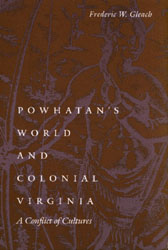 "This work sheds new light on the meaning of war and violence for both the Virginia Indians and the English who invaded them. And that leads to some stimulating new interpretations of the demise of the 1570 Spanish Mission, John Smith's captivity (including his rescue by Pocahontas), and the great attacks of 1622 and 1644." -Helen C. Rountree, Old Dominion University. "This fine new study . . . [pieces] together stories far richer and people far more complex than the literary and celluloid stereotypes that so dominate our views of this early encounter. Frederic Gleach steers us expertly through the cultural cross-currents, conflicts, and misunderstandings that swirled around the English founding of Virginia." -Jennifer S. H. Brown, University of Winnipeg. Drawing on the latest anthropological studies of colonial encounters, Frederic Gleach offers a more balanced and complete accounting of the early years of the Jamestown colony than has been seen before. When English colonists established their first permanent settlement at Jamestown in 1607, they confronted a powerful and growing native chiefdom consisting of over thirty tribes under one paramount chief, Powhatan. For the next half-century, a portion of the Middle Atlantic coastal plain became a charged and often violent meeting ground between two very different worlds. Gleach argues that the history of Jamestown is essentially the story of how two cultures with conflicting world-views attempted to civilize and incorporate each other. He examines historical events from both native and colonial perspectives, resulting in original and fuller interpretations of seventeenth-century Virginia history. Frederic W. Gleach is a visiting assistant professor in the Department of Anthropology at Cornell University. This is his first book.
"This work sheds new light on the meaning of war and violence for both the Virginia Indians and the English who invaded them. And that leads to some stimulating new interpretations of the demise of the 1570 Spanish Mission, John Smith's captivity (including his rescue by Pocahontas), and the great attacks of 1622 and 1644." -Helen C. Rountree, Old Dominion University. "This fine new study . . . [pieces] together stories far richer and people far more complex than the literary and celluloid stereotypes that so dominate our views of this early encounter. Frederic Gleach steers us expertly through the cultural cross-currents, conflicts, and misunderstandings that swirled around the English founding of Virginia." -Jennifer S. H. Brown, University of Winnipeg. Drawing on the latest anthropological studies of colonial encounters, Frederic Gleach offers a more balanced and complete accounting of the early years of the Jamestown colony than has been seen before. When English colonists established their first permanent settlement at Jamestown in 1607, they confronted a powerful and growing native chiefdom consisting of over thirty tribes under one paramount chief, Powhatan. For the next half-century, a portion of the Middle Atlantic coastal plain became a charged and often violent meeting ground between two very different worlds. Gleach argues that the history of Jamestown is essentially the story of how two cultures with conflicting world-views attempted to civilize and incorporate each other. He examines historical events from both native and colonial perspectives, resulting in original and fuller interpretations of seventeenth-century Virginia history. Frederic W. Gleach is a visiting assistant professor in the Department of Anthropology at Cornell University. This is his first book.
Prophecy and Power among the Dogrib Indians
June Helm
Cloth: 1994,xiv,17
CIP.LC 94-11841, 0-8032-2373-0
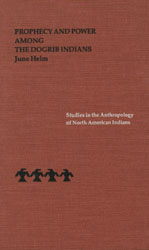 Dogrib Indians are one of the Dene groups - Athapaskan-speaking peoples of the western Canadian Subarctic. Based on the author's field studies from 1959 to 1976, this volume presents an ethnographic description of the Dogrib prophet movement. Part 1 introduces three prophets who came to prominence in the 1960s 1970s. Although they developed from the same cultural background and had the same aims, their prophetic styles contrasted dramatically with one another. Helm situates the prophet movement in relation to both aboriginal and Christian traditions and shows the determining importance of the prophets' personalities in shaping their practice of prophecy.
Dogrib Indians are one of the Dene groups - Athapaskan-speaking peoples of the western Canadian Subarctic. Based on the author's field studies from 1959 to 1976, this volume presents an ethnographic description of the Dogrib prophet movement. Part 1 introduces three prophets who came to prominence in the 1960s 1970s. Although they developed from the same cultural background and had the same aims, their prophetic styles contrasted dramatically with one another. Helm situates the prophet movement in relation to both aboriginal and Christian traditions and shows the determining importance of the prophets' personalities in shaping their practice of prophecy.
Part 2 examines the traditional Dogrib concept of power (ink'on), which underlies the prophet movement. It draws together information given over the course of years by Vital Thomas, a Dogrib who collaborated closely with Helm. This first-hand material is noteworthy for its personal perspective and for the understanding it provides of the differing sources and uses of power. The concept of power is so pervasive in daily life that it forms the key for understanding the dynamics of Dogrib culture. The book concludes with a brief autobiography related by Vital Thomas..
JUNE HELM received a Ph.D. from the University of Chicago and has for many years been a professor of anthropology at the University of Iowa. She is the editor of Subarctic, volume 6 of the Handbook of North American Indians, published by the Smithsonian Institution (1981).
Reserve Memories: The Power of the Past in a Chilcotin Community
David W. Dinwoodie
Cloth: 2002, xi, 120
CIP.LC 2001052239 ISBN : 0-8032-1721-8
 Reserve Memories examines how myths and narratives about the past have enabled a Northern Athabaskan community to understand and confront challenges and opportunities in the present. For over five centuries the Chilcotin people have lived in relative isolation in the rich timberlands and scattered meadows of the inland Northwest, in what is today known as west central British Columbia. Although linguistic and cultural changes are escalating, they remain one of the more traditional and little known Native communities in northwestern North America.
Reserve Memories examines how myths and narratives about the past have enabled a Northern Athabaskan community to understand and confront challenges and opportunities in the present. For over five centuries the Chilcotin people have lived in relative isolation in the rich timberlands and scattered meadows of the inland Northwest, in what is today known as west central British Columbia. Although linguistic and cultural changes are escalating, they remain one of the more traditional and little known Native communities in northwestern North America.
Combining years of fieldwork with an acute theoretical perspective, David W. Dinwoodie sheds light on the special power of the past for the Chilcotin people of the Nemiah Valley Indian Reserve. In different social and political settings, they draw upon a "reserve" of memories-in particular, myths and historical narratives-and reactivate them in order to help make sense of and deal effectively with the possibilities and problems of the modern world. For example, the declaration of the Chilcotins against clear-cut logging draws upon one of their central myths, adding a deeper and more lasting cultural significance and resonance to the political statement.
David W. Dinwoodie is an assistant professor of anthropology at the University of New Mexico. His articles have appeared in Anthropological Linguistics and Cultural Anthropology.
The Salish Language Family: Reconstructing Syntax
Paul D. Kroeber
Cloth: 1999, xxxi, 464
CIP.LC 99-18236 ISBN : 0-8032-2740-X
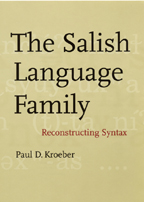 "A significant contribution to Salishan linguistics and more generally to the linguistics of Native America. It is, I believe, the most comprehensive comparative study of a set of syntactic structures to date for any language family in the Americas (and perhaps elsewhere as well). . . . The scholarship is impressive throughout.迫Sarah G. Thomason, editor of Contact Languages: A Wider Perspective.
"A significant contribution to Salishan linguistics and more generally to the linguistics of Native America. It is, I believe, the most comprehensive comparative study of a set of syntactic structures to date for any language family in the Americas (and perhaps elsewhere as well). . . . The scholarship is impressive throughout.迫Sarah G. Thomason, editor of Contact Languages: A Wider Perspective.
In this pioneering study Paul D. Kroeber examines the history of an array of important syntactic constructions in the Salish language family. This group of some twenty-three languages, centrally located in the Northwest Coast and Plateau Regions, is noted for its intriguing differences from European languages, including the possible irrelevance of a noun/verb distinction to grammatical structure and the existence of distinctive systems of articles, which also often function as marks of subordination.
Kroeber draws on and analyzes data from a wide range of textual and other sources. Centering his detailed investigation on patterns of subordination and focusing, he situates these against the broader background of Salish syntax, examines their interrelationships, and reconstructs their historical development. The result is a study that significantly enhances understanding of the structure and history of Salish. As important, Kroeber痴 critical command of sources and well-considered historical proposals are exemplary, setting a methodological standard for Americanist scholarship.
Paul D. Kroeber has written for International Journal of American Linguistics and Anthropological Linguistics. He is a research associate in the Department of Anthropology at Indiana University, Bloomington.
The Semantics of Time Aspectual Categorization in Koyukon Athabaskan
Melissa Axelrod
Cloth: 1993, xii, 200
CIP.LC 92-42719,0-8032-1032-9
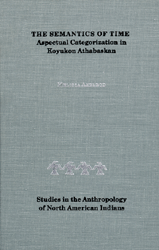 The languages of the Athabascan family are noted for their rich aspectual systems—inventories of grammatical forms that denote the nature of the action of a verb in relation to its beginning, duration, completion, or repetition, but without reference to its position in time. Koyukon is an Athabaskan language spoken along the Yukon and Koyukuk rivers in Alaska. Among Athabaskan languages, Koyukon has the most elaborate and profusely varied possibilities of morphologically marked derivational aspect.
The languages of the Athabascan family are noted for their rich aspectual systems—inventories of grammatical forms that denote the nature of the action of a verb in relation to its beginning, duration, completion, or repetition, but without reference to its position in time. Koyukon is an Athabaskan language spoken along the Yukon and Koyukuk rivers in Alaska. Among Athabaskan languages, Koyukon has the most elaborate and profusely varied possibilities of morphologically marked derivational aspect.
This work comprises three parts. The first describes the aspectual system, which sorts out a complex network of four modes, fifteen aspects, four superaspects, and some three hundred aspect-dependent derivation prefix strings. The second analyzes the organization of verb theme categories, which are directly linked to aspectual categories. The last assesses the function of the aspectual system as a whole.
MELISSA AXELROD received a Ph.D. in linguistics from the University of Colorado in lggo. She has worked for the Alaska Native Language Center, University of Alaska, Fairbanks, and currently teaches in the English Department at California State University, San Bernardino.
Tales from Maliseet Country
Philip S. LeSourd
Cloth: 2007, 200
ISBN : 978-0-8032-2962-4
 During the summer of 1963, Harvard linguist Karl V. Teeter traveled along the Saint John River, the great thoroughfare of Native New Brunswick, Canada, with his principal Maliseet consultant, Peter Lewis Paul. Together they recorded a series of tales from Maliseet elders whom Paul regarded as among the best Maliseet storytellers born before 1900, including Charles Laporte, Matilda Sappier, Solomon Polchies, William Saulis, and Alexander Sacobie. Paul also contributed eleven narratives of his own.
During the summer of 1963, Harvard linguist Karl V. Teeter traveled along the Saint John River, the great thoroughfare of Native New Brunswick, Canada, with his principal Maliseet consultant, Peter Lewis Paul. Together they recorded a series of tales from Maliseet elders whom Paul regarded as among the best Maliseet storytellers born before 1900, including Charles Laporte, Matilda Sappier, Solomon Polchies, William Saulis, and Alexander Sacobie. Paul also contributed eleven narratives of his own.
Tales from Maliseet Country presents the transcripts and translations of the texts Teeter collected, together with one tale recorded by linguist Philip S. LeSourd in 1977. The stories range from chronicles of shamanistic activity and mysterious events of the distant past, through more conventionally historical narratives, to frankly fictional yarns, fairy tales with roots in European traditions, and personal accounts of subsistence activities and reservation life. This entertaining and revealing volume testifies to the rich heritage of the Maliseets and the enduring vibrancy of their culture today.
Philip S. LeSourd is an associate professor of anthropology at Indiana University. He is the author of Accent and Syllable Structure in Passamaquoddy.
"They Treated Us Just Like Indians:" The Worlds of Bennett County, South Dakota
Paula L. Wagoner
Cloth: 2002, xv
CIP.LC 2002017963 ISBN : 0-8032-4800-8
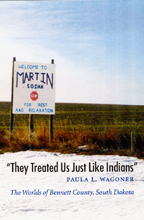 On a typical day in Bennett County, South Dakota, farmers and ranchers work their fields and tend animals, merchants order inventory and stock shelves, teachers plan and teach classes, health workers aid the infirm in the county hospital or clinic, and women make quilts and heirlooms for their families or the county fair. Life is usually unhurried, with time for chatting with neighbors and catching up on gossip. But Bennett County is far from typical.
On a typical day in Bennett County, South Dakota, farmers and ranchers work their fields and tend animals, merchants order inventory and stock shelves, teachers plan and teach classes, health workers aid the infirm in the county hospital or clinic, and women make quilts and heirlooms for their families or the county fair. Life is usually unhurried, with time for chatting with neighbors and catching up on gossip. But Bennett County is far from typical.
Nearly a century ago the county was carved out of Pine Ridge Reservation and opened to white settlers. Today Bennett County sits awkwardly between the Pine Ridge and Rosebud Sioux Reservations, with nearly one-third of its land classified as "Indian Country" and the rest considered by many Pine Ridge Lakotas to still belong to the reservation. The county is home to a dynamic population, divided by the residents into three groups—"whites," "full-bloods," and "mixed-bloods." Tensions between the three groups lurk amid the quiet harmony of Bennett County's everyday rural life and emerge in moments of community crisis.
In a moving account, anthropologist Paula L. Wagoner tells the story of Bennett County, using snapshots of community events and crises, past and present, to reveal the complexity of race relations and identities there. A homecoming weekend at Bennett County High School becomes a flashpoint for controversy because of the differences of meaning ascribed by the county's three identity groups to the school's team name—the Warriors. At another time, the shooting of a Lakota man by a local non-Indian rancher and the volatile wake that follows demonstrate the impulse to racialize disputes that lies just beneath the surface of everyday life.
Yet such very real problems of identity have not completely overwhelmed Bennett County. Wagoner also shows that despite their differences, residents have managed to find common ground as a region of "diverse insiders" who share an economic dependency on federal funds, distrust outsiders, and, above all, deeply love their land.
Paula L. Wagoner is an assistant professor of anthropology at Juniata College.
Traditional Narratives of the Arikara Indians (Interlinear translations) Volume 1 Stories of Alfred Morsette
Douglas R. Parks
Cloth: 1991,xxiv, 684
CIP.LC 90-12889,0-8032-3691-3
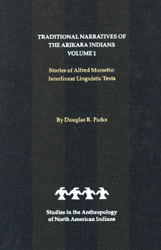 Until the late eighteenth century the Arikaras were one of the largest and most influential Indian groups on the northern plains. For centuries they have lived along the Missouri River, first in present South Dakota, later in what is now North Dakota. Today they share the Fort Berthold Indian Reservation in North Dakota with the Mandans and Hidatsas. Although their postcontact history and aspects of their culture are well documented, Douglas R. Parks's monumental four-volume work Traditional Narratives of the Arikara Indians represents the first comprehensive attempt to describe and record their language and literary traditions. Volumes 1 and 2 present transcriptions of 156 oral narratives in Arikara and include literal interlinear English translations. Volumes 3 and 4 contain free English translations of those narratives, making available for the first time a broad, representative group of Arikara oral traditions that will be invaluable not only to anthropologists and folklorists but to everyone interested in American Indian life and literature. The narratives cover the entire range of traditional stories found in the historical and literary tradition of the Arikara people, who classify their stories into two categories, true stories and tales. Here are myths of ancient times, legends of power bestowed, historical narratives, and narratives of mysterious incidents that affirm the existence today of supernatural power in the world, along with tales of the trickster Coyote and stories of the risque Stuwi and various other animals. In addition, there are accounts of Arikara ritualism: prayers and descriptions of how personal names are bestowed and how the Death Feast originated.
Until the late eighteenth century the Arikaras were one of the largest and most influential Indian groups on the northern plains. For centuries they have lived along the Missouri River, first in present South Dakota, later in what is now North Dakota. Today they share the Fort Berthold Indian Reservation in North Dakota with the Mandans and Hidatsas. Although their postcontact history and aspects of their culture are well documented, Douglas R. Parks's monumental four-volume work Traditional Narratives of the Arikara Indians represents the first comprehensive attempt to describe and record their language and literary traditions. Volumes 1 and 2 present transcriptions of 156 oral narratives in Arikara and include literal interlinear English translations. Volumes 3 and 4 contain free English translations of those narratives, making available for the first time a broad, representative group of Arikara oral traditions that will be invaluable not only to anthropologists and folklorists but to everyone interested in American Indian life and literature. The narratives cover the entire range of traditional stories found in the historical and literary tradition of the Arikara people, who classify their stories into two categories, true stories and tales. Here are myths of ancient times, legends of power bestowed, historical narratives, and narratives of mysterious incidents that affirm the existence today of supernatural power in the world, along with tales of the trickster Coyote and stories of the risque Stuwi and various other animals. In addition, there are accounts of Arikara ritualism: prayers and descriptions of how personal names are bestowed and how the Death Feast originated.
Traditional Narratives of the Arikara Indians, Volume 2 Stories of Other Narrators
Douglas R. Parks
Cloth: 1991,xiv,659
CIP.LC 90-12889,0-8032-3692-1
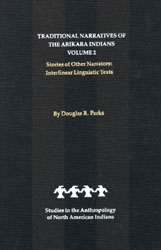 Until the late eighteenth century the Arikaras were one of the largest and most influential Indian groups on the northern plains. For centuries they have lived along the Missouri River, first in present South Dakota, later in what is now North Dakota. Today they share the Fort Berthold Indian Reservation in North Dakota with the Mandans and Hidatsas. Although their postcontact history and aspects of their culture are well documented, Douglas R. Parks's monumental four-volume work Traditional Narratives of the Arikara Indians represents the first comprehensive attempt to describe and record their language and literary traditions. Volumes 1 and 2 present transcriptions of 156 oral narratives in Arikara and include literal interlinear English translations. Volumes 3 and 4 contain free English translations of those narratives, making available for the first time a broad, representative group of Arikara oral traditions that will be invaluable not only to anthropologists and folklorists but to everyone interested in American Indian life and literature. The narratives cover the entire range of traditional stories found in the historical and literary tradition of the Arikara people, who classify their stories into two categories, true stories and tales. Here are myths of ancient times, legends of power bestowed, historical narratives, and narratives of mysterious incidents that affirm the existence today of supernatural power in the world, along with tales of the trickster Coyote and stories of the risque Stuwi and various other animals. In addition, there are accounts of Arikara ritualism: prayers and descriptions of how personal names are bestowed and how the Death Feast originated.
Until the late eighteenth century the Arikaras were one of the largest and most influential Indian groups on the northern plains. For centuries they have lived along the Missouri River, first in present South Dakota, later in what is now North Dakota. Today they share the Fort Berthold Indian Reservation in North Dakota with the Mandans and Hidatsas. Although their postcontact history and aspects of their culture are well documented, Douglas R. Parks's monumental four-volume work Traditional Narratives of the Arikara Indians represents the first comprehensive attempt to describe and record their language and literary traditions. Volumes 1 and 2 present transcriptions of 156 oral narratives in Arikara and include literal interlinear English translations. Volumes 3 and 4 contain free English translations of those narratives, making available for the first time a broad, representative group of Arikara oral traditions that will be invaluable not only to anthropologists and folklorists but to everyone interested in American Indian life and literature. The narratives cover the entire range of traditional stories found in the historical and literary tradition of the Arikara people, who classify their stories into two categories, true stories and tales. Here are myths of ancient times, legends of power bestowed, historical narratives, and narratives of mysterious incidents that affirm the existence today of supernatural power in the world, along with tales of the trickster Coyote and stories of the risque Stuwi and various other animals. In addition, there are accounts of Arikara ritualism: prayers and descriptions of how personal names are bestowed and how the Death Feast originated.
Traditional Narratives of the Arikara Indians, English Translations, Volume 3 Stories of Alfred Morsette
Douglas R. Parks
Cloth: 1992,xxvi,468
CIP.LC 90-12889,0-8032-3694-8
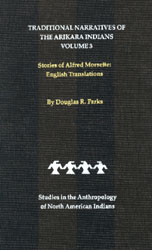 Until the late eighteenth century the Arikaras were one of the largest and most influential Indian groups on the northern plains. For centuries they have lived along the Missouri River, first in present South Dakota, later in what is now North Dakota. Today they share the Fort Berthold Indian Reservation in North Dakota with the Mandans and Hidatsas. Although their postcontact history and aspects of their culture are well documented, Douglas R. Parks's monumental four-volume work Traditional Narratives of the Arikara Indians represents the first comprehensive attempt to describe and record their language and literary traditions. Volumes 1 and 2 present transcriptions of 156 oral narratives in Arikara and include literal interlinear English translations. Volumes 3 and 4 contain free English translations of those narratives, making available for the first time a broad, representative group of Arikara oral traditions that will be invaluable not only to anthropologists and folklorists but to everyone interested in American Indian life and literature. The narratives cover the entire range of traditional stories found in the historical and literary tradition of the Arikara people, who classify their stories into two categories, true stories and tales. Here are myths of ancient times, legends of power bestowed, historical narratives, and narratives of mysterious incidents that affirm the existence today of supernatural power in the world, along with tales of the trickster Coyote and stories of the risque Stuwi and various other animals. In addition, there are accounts of Arikara ritualism: prayers and descriptions of how personal names are bestowed and how the Death Feast originated.
Until the late eighteenth century the Arikaras were one of the largest and most influential Indian groups on the northern plains. For centuries they have lived along the Missouri River, first in present South Dakota, later in what is now North Dakota. Today they share the Fort Berthold Indian Reservation in North Dakota with the Mandans and Hidatsas. Although their postcontact history and aspects of their culture are well documented, Douglas R. Parks's monumental four-volume work Traditional Narratives of the Arikara Indians represents the first comprehensive attempt to describe and record their language and literary traditions. Volumes 1 and 2 present transcriptions of 156 oral narratives in Arikara and include literal interlinear English translations. Volumes 3 and 4 contain free English translations of those narratives, making available for the first time a broad, representative group of Arikara oral traditions that will be invaluable not only to anthropologists and folklorists but to everyone interested in American Indian life and literature. The narratives cover the entire range of traditional stories found in the historical and literary tradition of the Arikara people, who classify their stories into two categories, true stories and tales. Here are myths of ancient times, legends of power bestowed, historical narratives, and narratives of mysterious incidents that affirm the existence today of supernatural power in the world, along with tales of the trickster Coyote and stories of the risque Stuwi and various other animals. In addition, there are accounts of Arikara ritualism: prayers and descriptions of how personal names are bestowed and how the Death Feast originated.
Traditional Narratives of the Arikara Indians, English Translations, Volume 4 Stories of Other Narrators
Douglas R. Parks
Cloth: 1992,xvii,431
CIP.LC 90-12889,0-8032-3695-6
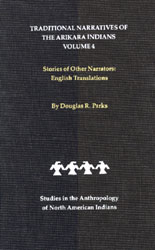 Until the late eighteenth century the Arikaras were one of the largest and most influential Indian groups on the northern plains. For centuries they have lived along the Missouri River, first in present South Dakota, later in what is now North Dakota. Today they share the Fort Berthold Indian Reservation in North Dakota with the Mandans and Hidatsas. Although their postcontact history and aspects of their culture are well documented, Douglas R. Parks's monumental four-volume work Traditional Narratives of the Arikara Indians represents the first comprehensive attempt to describe and record their language and literary traditions. Volumes 1 and 2 present transcriptions of 156 oral narratives in Arikara and include literal interlinear English translations. Volumes 3 and 4 contain free English translations of those narratives, making available for the first time a broad, representative group of Arikara oral traditions that will be invaluable not only to anthropologists and folklorists but to everyone interested in American Indian life and literature. The narratives cover the entire range of traditional stories found in the historical and literary tradition of the Arikara people, who classify their stories into two categories, true stories and tales. Here are myths of ancient times, legends of power bestowed, historical narratives, and narratives of mysterious incidents that affirm the existence today of supernatural power in the world, along with tales of the trickster Coyote and stories of the risque Stuwi and various other animals. In addition, there are accounts of Arikara ritualism: prayers and descriptions of how personal names are bestowed and how the Death Feast originated.
Until the late eighteenth century the Arikaras were one of the largest and most influential Indian groups on the northern plains. For centuries they have lived along the Missouri River, first in present South Dakota, later in what is now North Dakota. Today they share the Fort Berthold Indian Reservation in North Dakota with the Mandans and Hidatsas. Although their postcontact history and aspects of their culture are well documented, Douglas R. Parks's monumental four-volume work Traditional Narratives of the Arikara Indians represents the first comprehensive attempt to describe and record their language and literary traditions. Volumes 1 and 2 present transcriptions of 156 oral narratives in Arikara and include literal interlinear English translations. Volumes 3 and 4 contain free English translations of those narratives, making available for the first time a broad, representative group of Arikara oral traditions that will be invaluable not only to anthropologists and folklorists but to everyone interested in American Indian life and literature. The narratives cover the entire range of traditional stories found in the historical and literary tradition of the Arikara people, who classify their stories into two categories, true stories and tales. Here are myths of ancient times, legends of power bestowed, historical narratives, and narratives of mysterious incidents that affirm the existence today of supernatural power in the world, along with tales of the trickster Coyote and stories of the risque Stuwi and various other animals. In addition, there are accounts of Arikara ritualism: prayers and descriptions of how personal names are bestowed and how the Death Feast originated.
Traditional Narratives of the Arikara Indians
Douglas R. Parks
Cloth: 1991
2 Audiocassettes
CIP.LC 90-12889,0-8032-3697-2
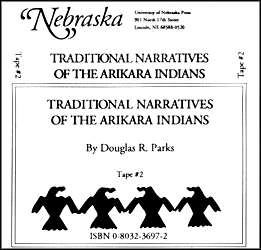 Until the late eighteenth century the Arikaras were one of the largest and most influential Indian groups on the northern plains. For centuries they have lived along the Missouri River, first in present South Dakota, later in what is now North Dakota. Today they share the Fort Berthold Indian Reservation in North Dakota with the Mandans and Hidatsas. Although their postcontact history and aspects of their culture are well documented, Douglas R. Parks's monumental four-volume work Traditional Narratives of the Arikara Indians represents the first comprehensive attempt to describe and record their language and literary traditions. Volumes 1 and 2 present transcriptions of 156 oral narratives in Arikara and include literal interlinear English translations. Volumes 3 and 4 contain free English translations of those narratives, making available for the first time a broad, representative group of Arikara oral traditions that will be invaluable not only to anthropologists and folklorists but to everyone interested in American Indian life and literature. The narratives cover the entire range of traditional stories found in the historical and literary tradition of the Arikara people, who classify their stories into two categories, true stories and tales. Here are myths of ancient times, legends of power bestowed, historical narratives, and narratives of mysterious incidents that affirm the existence today of supernatural power in the world, along with tales of the trickster Coyote and stories of the risque Stuwi and various other animals. In addition, there are accounts of Arikara ritualism: prayers and descriptions of how personal names are bestowed and how the Death Feast originated.
Until the late eighteenth century the Arikaras were one of the largest and most influential Indian groups on the northern plains. For centuries they have lived along the Missouri River, first in present South Dakota, later in what is now North Dakota. Today they share the Fort Berthold Indian Reservation in North Dakota with the Mandans and Hidatsas. Although their postcontact history and aspects of their culture are well documented, Douglas R. Parks's monumental four-volume work Traditional Narratives of the Arikara Indians represents the first comprehensive attempt to describe and record their language and literary traditions. Volumes 1 and 2 present transcriptions of 156 oral narratives in Arikara and include literal interlinear English translations. Volumes 3 and 4 contain free English translations of those narratives, making available for the first time a broad, representative group of Arikara oral traditions that will be invaluable not only to anthropologists and folklorists but to everyone interested in American Indian life and literature. The narratives cover the entire range of traditional stories found in the historical and literary tradition of the Arikara people, who classify their stories into two categories, true stories and tales. Here are myths of ancient times, legends of power bestowed, historical narratives, and narratives of mysterious incidents that affirm the existence today of supernatural power in the world, along with tales of the trickster Coyote and stories of the risque Stuwi and various other animals. In addition, there are accounts of Arikara ritualism: prayers and descriptions of how personal names are bestowed and how the Death Feast originated.
Wolverine Myths and Visions Dene Traditions from Northern Alberta
Angela Wheelock, Patrick J. Moore
Cloth: 1990,xvi,259
CIP.LC 89-29379,0-8032-8161-7
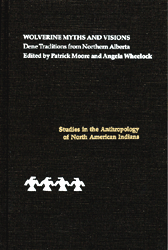 The people who call themselves Dene Dhaa, a group of the Athapaskan-speaking Natives of northwestern Canada known as the Slave or Slavey Indians, now number about one thousand and occupy three reserves in northwestern Alberta. Because their settlements were until recently widely dispersed and isolated, they have maintained their language and traditions more successfully than most other Indian groups. This collection of their stories, recorded in the Dene language with literal interlinear English glosses and in a free English translation, represents a major contribution to the documentation of the Dene language, ethnography, and folklore.
The people who call themselves Dene Dhaa, a group of the Athapaskan-speaking Natives of northwestern Canada known as the Slave or Slavey Indians, now number about one thousand and occupy three reserves in northwestern Alberta. Because their settlements were until recently widely dispersed and isolated, they have maintained their language and traditions more successfully than most other Indian groups. This collection of their stories, recorded in the Dene language with literal interlinear English glosses and in a free English translation, represents a major contribution to the documentation of the Dene language, ethnography, and folklore.
Patrick J. Moore is a linguist with the Yukon Native Language Centre; Angela Wheelock is a freelance writer.
Yuchi Ceremonial Life: Performance, Meaning, and Tradition in a Contemporary American Indian Community
Jason Baird Jackson
Cloth: 2003, xx, 345
CIP.LC 2002031957 ISBN : 0-8032-2594-6
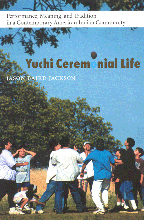 The Yuchis are one of the least known yet most distinctive of the Native groups in the American southeast. Located in late prehistoric times in eastern Tennessee, they played an important historical role at various times during the last five centuries and in many ways served as a bridge between their southeastern neighbors and Native communities in the northeast. First noted by the de Soto expedition in the sixteenth century, the Yuchis moved several times and made many alliances over the next few centuries. The famous naturalist William Bartram visited a Yuchi town in 1775, at a time when the Yuchis had moved near and become allied with Creek communities in Georgia. This alliance had long-lasting repercussions: when the United States government forced most southeastern groups to move to Oklahoma in the early nineteenth century, the Yuchis were classified as Creeks and placed under the jurisdiction of the Creek Nation. Today, despite the existence of a separate language and their distinct history, culture, and religious traditions, the Yuchis are not recognized as a sovereign people by the Creek Nation or the United States.
The Yuchis are one of the least known yet most distinctive of the Native groups in the American southeast. Located in late prehistoric times in eastern Tennessee, they played an important historical role at various times during the last five centuries and in many ways served as a bridge between their southeastern neighbors and Native communities in the northeast. First noted by the de Soto expedition in the sixteenth century, the Yuchis moved several times and made many alliances over the next few centuries. The famous naturalist William Bartram visited a Yuchi town in 1775, at a time when the Yuchis had moved near and become allied with Creek communities in Georgia. This alliance had long-lasting repercussions: when the United States government forced most southeastern groups to move to Oklahoma in the early nineteenth century, the Yuchis were classified as Creeks and placed under the jurisdiction of the Creek Nation. Today, despite the existence of a separate language and their distinct history, culture, and religious traditions, the Yuchis are not recognized as a sovereign people by the Creek Nation or the United States.
Jason Baird Jackson examines the significance of community ceremonies for the Yuchis today. For many Yuchis, traditional rituals remain important to their identity, and they feel an obligation to perform and renew them each year at one of three ceremonial grounds, called “Big Houses.” The Big House acts as a periodic gathering place for the Yuchis, their Creator, and their ancestors. Drawing on a decade of collaborative study with tribal elders and using insights gained from ethnopoetics, Jackson captures in vivid detail the performance, impact, and motivations behind such rituals as the Stomp Dance, the Green Corn Ceremony, and the Soup Dance and discusses their continuing importance to the community.



